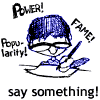![[ NEWS ]](/images/news97.gif)
Arizona Daily Wildcat February 27, 1997
Technology conference returns to UA
![[photograph]](01_2_i.gif)
|
Charles C. Labenz
The Information System and Learning Year 2000 Conference, hosted by the University Networked Information Technology Environment was held yesterday in the Memorial Student Union Arizona Ballroom. The conference was designed to educate students and faculty on the rapid changes in technology.
|
The UA is seeking strategies today and Friday to respond to the rapid changes in technology at Information Systems and Learning - Year 2000.
"Education faces enormous challenges and opportunities as both our technology and methods of collecting and presenting knowledge change at a bewildering rate," said Roger Caldwell, professor of soil, water and environmental science.
Caldwell said the theme of the second annual IS&L 2000 conference is "Leading in Learning: Changing Methods and Tools."
The conference, hosted by the University Networked Information Technology Environment, will be in the Memorial Student Union's Arizona and Senior ballrooms.
Robert MacArthur, conference chair and coordinator for Instruction Computer Applications on campus, said the conference was started last year to build partnerships on strategic information systems issues.
"Students, faculty and staff are getting together to find out about new learning technologies," he said.
The conference targets anyone interested in the University of Arizona's mission to improve education for students, the public and participating client groups, MacArthur said.
He said the university wants to develop information strategies across campus as well as course materials for grades K-12 and community colleges.
Caldwell said about one-fourth of the university's faculty implements listservs and computer conferences in its classroom curriculum. He said the World Wide Web has only been around for three years.
"So the faculty is responding pretty quickly," Caldwell said.
Caldwell said these methods are taking place at other universities across the nation.
A student can take certain classes not offered at the UA from other universities on the Internet.
Caldwell said the Western Governor's University proposal, an online university, is an example of the challenges the UA is facing. The "virtual" university will allow students to study via modem and be awarded their degree from a traditional university.
He stressed more companies and universities are putting together programs that allow students to learn on their own.
"It (the conference) is going to make big impacts on how people learn," Caldwell said. "It's directed at getting everybody up to speed in changes in learning."
The university invited several companies to participate in the conference, including IBM Corp. and Hewlett Packard Company.
The companies will explain the ways they incorporate technology and learning.
"We're taking a limited amount of knowledge and making it accessible to a large number of people," Caldwell said.
The Health Sciences Library and the College of Medicine are founding participants of the Arizona Health Information Network. The network allows physicians in Phoenix to access the same information databases as health providers in Tucson.
The network provides information resources for all health care providers in Arizona. It will eventually be updated to allow patients to access the same databases from outside the library.
Mari Stoddard, head of educational services for the Arizona Health Sciences Library, will present tutorials on accessing information over the Internet.
Stoddard said patients can get "information prescriptions" from the library, which will allow a patient to research a disease as well as its symptoms and treatment.
Other people might just want to check out whether or not red wine is good for them, she said.
"We wanted to talk to people who need access to information," Stoddard said, referring to the IS&L 2000 conference.
Stoddard said the UA is the Internet provider for anyone on campus.
The university offers access to the Encyclopedia Britannica, SABIO databases and Health Science Library databases.
Anyone with an on-campus account has access to this information, Stoddard said.
The conference is open to all students, staff and faculty. It runs today from 8 a.m. to 4:30 p.m. and Friday from 8:30 a.m. to 3 p.m.



